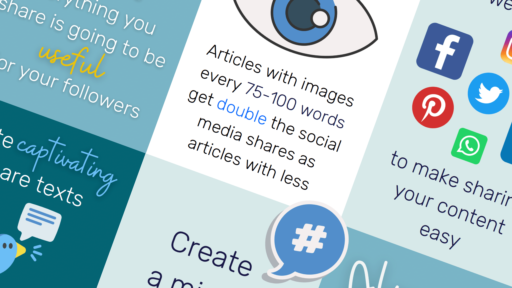Competition for customers is fiercer than it’s ever been.
You can’t just have a solid product and affordable pricing these days. Consumers are looking for something more. And there are plenty of places to find it.
Customers want to be at the heart of your business. So, you need to show them that they are. Their experience should be fast, frictionless, and consistent. It’s becoming the new standard.
As part of your brand awareness strategy, content you create or share will be a lot of people’s first touchpoint with your business. Here’s how to use it for a customer-centric marketing strategy. And make it count.
What is customer-centricity in marketing?
Customer-centric marketing is all about creating a positive experience for your target audience. You’re showing you’ll meet customer needs – before they even ask!
Global e-commerce giant Amazon is famed for this because of founder Jeff Bezos’ business strategy:
“The most important single thing is to focus obsessively on the customer. Our goal is to be earth’s most customer-centric company.”

Source: Zendesk
To do this, you first have to understand your audience and what they want. This means you need to get to know your customers as part of your brand strategy.
Creating customer (or buyer) personas is the best way to do this. By building fictional representations of different segments of your audience, you learn how to market to each of them.
Each digital marketing campaign won’t be aimed at everyone. And that’s ok!

Source: Cacoo
So, where do you find the customer data to build these?
Well, you can find this by diving into your:
- CRM (customer relationship manager)
- Google Analytics for your site
- Social stats
- Transaction records
- Customer behavior tracking
Or you can go old school and just simply ask your customers. Surveys and interviews let your customers tell you what they want themselves. What they really, really want.
These days, people take a ton of time comparing brands and businesses. Customer retention and advocacy have to be earned. They’re not guaranteed.
You don’t have to have an obsessive customer-centric culture like Amazon. But give yourself a competitive advantage by showing you care.
Creating a customer-centric approach with content marketing
Customer-centric companies make sure their users are at the forefront of their product or service. Customer satisfaction is key here. And it all revolves around the experience you’re providing.
In a recent survey, 45.9% of businesses put customer experience as a top priority over pricing and product.

Source: SuperOffice
Your customer experience (or CX) can involve so many things:
- The quality of customer support
- Your marketing approach
- Rewards for customer loyalty
- The way your service works
- How you sell your product
The strategy for these will differ massively between companies. But there’s one huge area of CX that can be improved with the same method by everyone: content marketing.
Here are 7 ways to use content for a customer-centric marketing strategy:
- Create content that adds value to the customer journey
- Keep your customers engaged with storytelling
- Great content should solve your customers’ problems
- A mix of different content types will appeal to everyone
- Make content super shareable for social media
- Increase engagement to inspire brand loyalty
- Create a consistent customer experience across all channels
1. Create content that adds value to the customer journey
We all used to rely upon the “marketing funnel” to track the customer journey. There were 3 or 4 stages to this (depending on who you asked):
- Awareness
- Consideration
- Decision
- Buy
But with the arrival of search engines and automation came a big shake-up. Now, there’s a new funnel. Or flywheel. Or map. Or whatever the heck you decide it is.

Source: Emplifi
No customer journey is the same. But if you’re trying to entice new customers, you need one thing that is – content that shows just how valuable you’re going to be for them.
Indirect marketing helps to build a relationship with your target audience. You’re not a promoter shouting, “Here we are, buy what we’re selling!” You’re showing you’re a customer-centric business by creating content that focuses on helping.
Your content needs to appeal to the right buyer at the right time. It should also align with those different buyer personas you’ve created.

Source: GatherContent
Take the above example of a customer journey map for an 18-year old buying car insurance. You could create a how-to video for the “feeling” stage of the “bond and enjoy” section, all about how to keep a new car in great condition.
Be as imaginative as you can. There’s a world of the content you could create for each part of the map that’ll benefit your customers in real-time.
2. Keep your customers engaged with storytelling
Storytelling is something humans have done since the dawn of time. It’s how we communicate and relate to one another. It’s also how we get others to engage with us. And marketing is all about engaging potential customers.
The story behind successful customer-centric content marketing is what grabs people’s attention. It’s got to be:
- Educational
- Entertaining
- Inspiring
- Upsetting
- Surprising
- Or all of the above!
Storytelling doesn’t focus on metrics or data to show how a product works. It shows you. That’s the differentiator. And it’s what’ll set you apart from your competitors.
Google’s annual “Year In Search” videos are a great example of brand storytelling through content. At the end of each year, it rounds up user data to find the most-searched terms:
It taps into the collective emotions from events of the past year to create a video that engages its audience. Without this data, it wouldn’t be able to create such hard-hitting content.
Or check out this true story from Land Rover:
The video follows the journey of some villagers of Maneybhanjang. They have 42 Land Rovers from the ‘50s that they use on treacherous roads to reach a village at an altitude of 3,636m.
There’s no real self-promotion involved here. It focuses on the users of their product. But the takeaway is obviously the remarkable power and longevity of the vehicles.
Visuals are always a winner, but storytelling applies to all mediums. You can capture the imagination of your customers through words or sound too.
3. Great content should solve your customers’ problems
Dyson is known for making everyday household items. But James Dyson’s first commercially-sold invention in the ‘70s was actually a re-invention of the wheelbarrow.
He took a product that had remained the same for hundreds of years and updated every part that frustrated him as a user. He replaced the wheels with a ball and added bigger “feet” that didn’t sink into soft ground. Plus, a dumper truck-shaped bin to stop water and cement slopping out the sides.
Dyson’s products are all born out of being annoyed and angry at everyday products that don’t work as they should. The company then uses cutting-edge technology and ideas to revolutionize them.
They focus on making their products lighter, more environmentally friendly, and increasing their lifespan. Because that’s what their users want.
Their customer-centric content marketing mirrors these values. Check out this quick ad below. It’s cinematic, futuristic, and makes vacuuming your entire house look a breeze.
Dyson is a customer-centric organization because it promises to continue to make people’s lives easier. They know that to maintain and increase their customer lifetime value, they’ve got to keep innovating.
Through their marketing efforts and content, they’re proving they are listening to their customers. Your content should demonstrate how you are too.
4. Include different content types that’ll appeal to everyone
Blog articles are great. We love them. They’re the easiest type of content to put together. But not everyone is a fan of reading 1000s of words.
Humans are visual creatures, so it’s no surprise the “primary form of media used in content marketing is video”. And there are loads of types of video content you can create! Videos that promote new products/services and brand storytelling are two of the most popular.

Source: HubSpot
But there are so many other types you can choose from too:
- Webinars
- Podcasts
- Slideshows
- Quizzes
- Surveys
- Games
The ‘Il Makiage PowerMatch Quiz’ is a great example that’s all over Instagram. It claims to be able to find your perfect foundation color using a few multiple-choice questions and images of different skin colors.

Source: Il Makiage
Content marketing doesn’t get more customer-centric than this. The interactive quiz is a clever way of targeting and personalizing the experience of each new potential customer.
And you can do it too. Simply:
- Get to know your customer base
- Understand their pain points
- Create different types of imaginative content
Curated content can help if you’re struggling to create enough different types. Quuu can help you there! But you still have to put in effort here to make sure you’re picking stuff that’s on-brand and relevant for your audience.
5. Make content super shareable for social media
Social media and content go hand in hand.
Back in the day, timelines and feeds were chronological, so your users never missed a thing. Nowadays, we’re all battling algorithms that seem totally random. Because of this, most content is ignored or missed.
If you want your customers to see the content you’re creating for them, it’s got to stand out. This goes for content curation too. Anything you’re sharing on your social channels has to be something you know your audience will enjoy.
66% of people believe social shares are linked to search engine optimization (SEO). But making people share is easier said than done. And a lot of it can depend on the type of content and which network you’re posting it on.

Source: Databox
Usually, it’s long-form content for LinkedIn. Images for Instagram. Trends for TikTok. But you know what your audience likes. So, if it’s the opposite, then go for it!
Here are a few tips to make your content super shareable for social media:
- Make sure it’s useful for your customers
- Keep it visual
- Add social share buttons to your blog
- Always be original
- Create a mix of evergreen and trending content
- Write captivating share texts
- Turn content into an infographic
- Evoke emotions with storytelling
- Stay relevant to your niche
If you’re curating content, adding unique value to your share texts is the best way to increase shareability. You can use a scheduler like socialchief to do this and plan ahead. Just remember the golden rule – always credit the source.
6. Increase engagement to inspire brand loyalty
This leads nicely into our next section: the importance of engagement for customer-centric marketing. And we’re not just talking about getting your audience to engage with your content.
Social media engagement is a two-way street. If you want it, you’ve gotta give it.
People love it when their favorite brand engages with them. Fast-food chain Wendy’s built a reputation by replying to rude comments in a sassy way. It worked so well; their customers now ask them to roast them on the daily:
It’s a great way of encouraging brand loyalty. Because you’re showing your customers you care about them. You’re not just moving on from them after they buy. But engagement doesn’t only mean replying to comments on social media.
Engagement can come in the form of content itself. Take guitar manufacturer Fender, for example. They did some research and found that 90% of first-time guitar players will quit within 6 months.
Now, you could argue that once they’ve sold a guitar, their work is done. But Fender realized if they upgraded their customer journey to support players before this 6-month mark, they could inspire long-term loyalty.
So, they created a series of apps to engage with their customers. From guitar tuners to Fender Play for tutorials and lessons, they’ve created a customer-centric culture with content. Plus, additional bonus revenue!
Could you do something similar?
7. Provide a consistent customer experience across all channels
Any customer success strategy relies on consistency across all channels:
- Your website
- All social media accounts
- Live chat
- Customer support
- Physical stores
That’s why omnichannel marketing is so important. Because your customer segments aren’t all in the same place. But they all need to have the same experience.

Source: Knorex
Over half of the global population is on some form of social media. Having a presence on the main social media networks increases brand awareness and trust. That’s a fact. But it’s no use if you put all your marketing efforts into just one channel.
Consistency, of course, applies to the look of your social profiles. Profile pictures, taglines, and color schemes should all match or fit the same aesthetic. But what about your content?
Well, you need to post consistently for a start. There’s no point in having a profile somewhere if you’re not using it. Better to not be there at all! But you can’t just post any old garbage to look as though you’re active.
In terms of the content itself, keep everything visual. Visual content works on every platform. People are drawn to it. But it’s all gotta be the same high standard. Stay away from stock images and try Unsplash instead.

Source: Unsplash
Long-form written content can be linked with an image or video as the cover shot. But be aware. Users of sites like Instagram and TikTok tend to scroll through tons of content on the same app without following up on any links.
Do some research and maybe keep longer-form types of content for Twitter, Facebook, and LinkedIn instead. People on those sites expect to click off to content elsewhere.
Whatever you’re posting, keep it high-quality and keep it relevant. Those are the two things that have to be consistent to keep your customers happy.
Conclusion
Making your marketing customer-centric isn’t hard to do. After you’ve got the data to back up your decisions, that is.
You just have to always keep your customer top-of-mind with your content. This’ll be a breeze as long as you know:
- Who you’re selling to
- What frustrates them
- What they enjoy
- Which of their problems you could solve
Once you’ve nailed that, you’ll find it a lot easier to create and curate content they’ll love.
Are there any examples of customer-centric brands you love? What type of content appeals to consumers best? Let us know in the comments!





